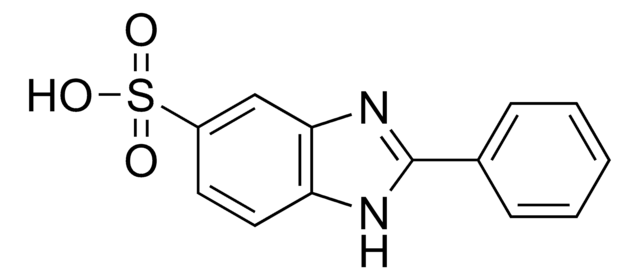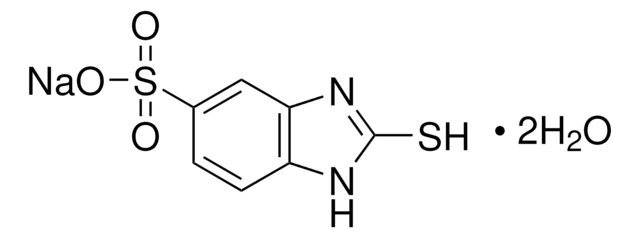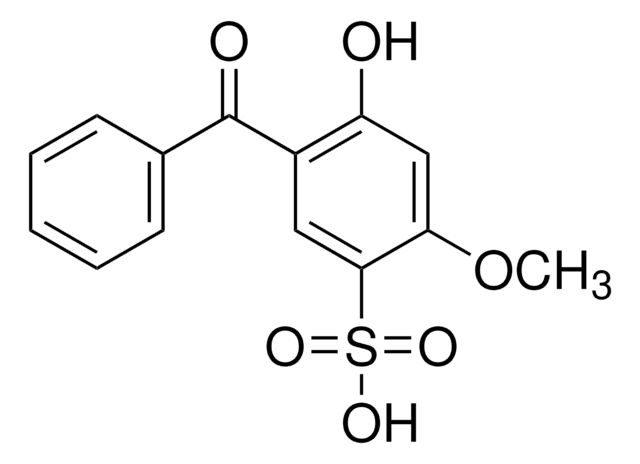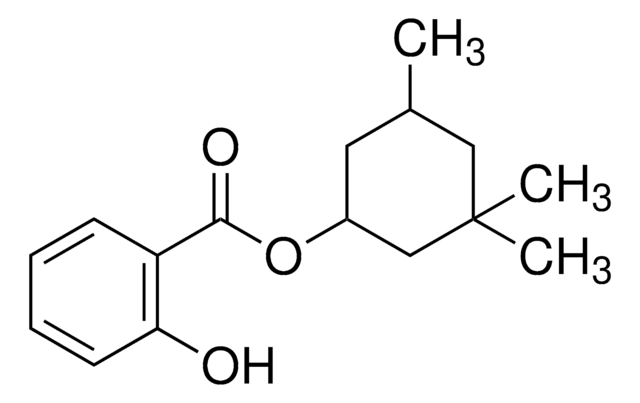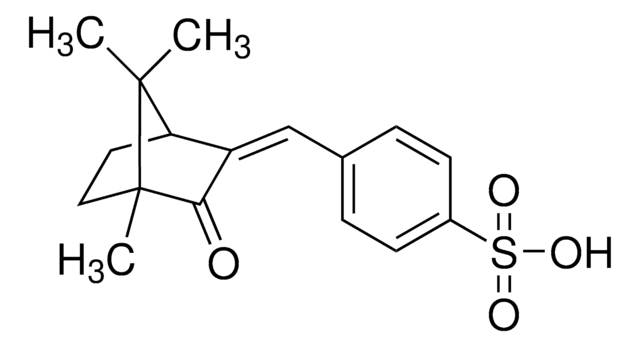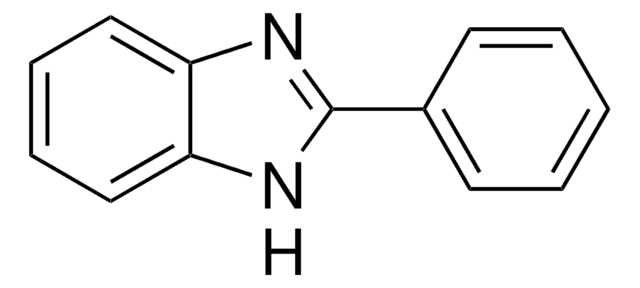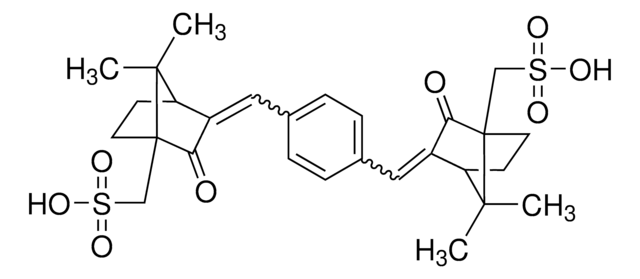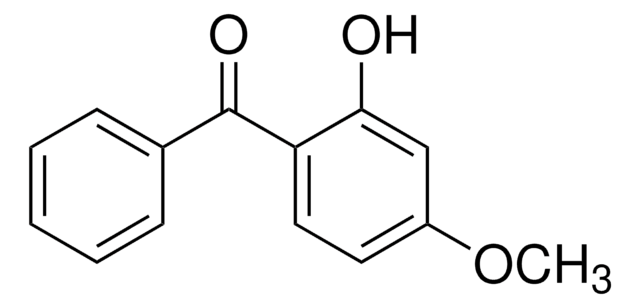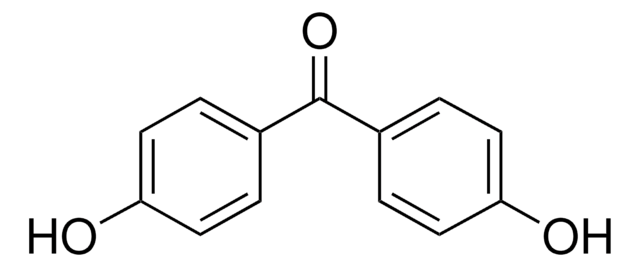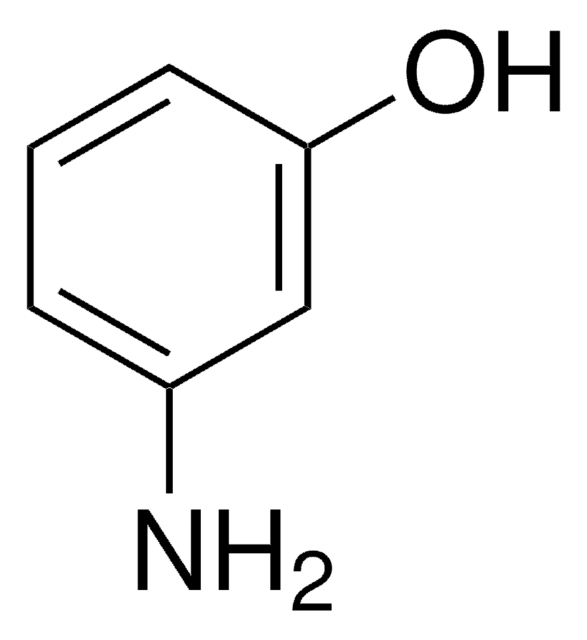Wszystkie zdjęcia(3)
Kluczowe dokumenty
437166
2-Phenyl-5-benzimidazolesulfonic acid
96%
Synonim(y):
Ensulizole
Zaloguj sięWyświetlanie cen organizacyjnych i kontraktowych
About This Item
Wzór empiryczny (zapis Hilla):
C13H10N2O3S
Numer CAS:
Masa cząsteczkowa:
274.30
Numer MDL:
Kod UNSPSC:
12352100
Identyfikator substancji w PubChem:
NACRES:
NA.22
Polecane produkty
Poziom jakości
Próba
96%
mp
>300 °C (lit.)
rozpuszczalność
ethanol and water: soluble (as sodium salt)
grupa funkcyjna
phenyl
sulfonic acid
ciąg SMILES
OS(=O)(=O)c1ccc2[nH]c(nc2c1)-c3ccccc3
InChI
1S/C13H10N2O3S/c16-19(17,18)10-6-7-11-12(8-10)15-13(14-11)9-4-2-1-3-5-9/h1-8H,(H,14,15)(H,16,17,18)
Klucz InChI
UVCJGUGAGLDPAA-UHFFFAOYSA-N
Szukasz podobnych produktów? Odwiedź Przewodnik dotyczący porównywania produktów
Powiązane kategorie
Opis ogólny
2-Phenyl-5-benzimidazolesulfonic acid has been reported as UV filter. It is a xenobiotic compound detected in in gray water from houses and effluents of the biological treatment systems (aerobic, anaerobic, and combined anaerobic+aerobic). It is a micropollutant of personal care products and its removal from aerobically treated grey water by ozonation and adsorption onto activated carbon has been reported.
Zastosowanie
2-Phenyl-5-benzimidazolesulfonic acid was used for the fabrication of biomimetic sensor for determination of 4-methylbenzylidene camphor (4-MBC), an ultraviolet (UV) radiation protector.
UV absorber
Ta strona może zawierać tekst przetłumaczony maszynowo.
Kod klasy składowania
11 - Combustible Solids
Klasa zagrożenia wodnego (WGK)
WGK 1
Temperatura zapłonu (°F)
Not applicable
Temperatura zapłonu (°C)
Not applicable
Wybierz jedną z najnowszych wersji:
Masz już ten produkt?
Dokumenty związane z niedawno zakupionymi produktami zostały zamieszczone w Bibliotece dokumentów.
Klienci oglądali również te produkty
Lucía Hernández Leal et al.
Environmental science & technology, 44(17), 6835-6842 (2010-08-05)
Eighteen selected xenobiotics related to personal care and household chemicals (UV-filters, fragrances, preservatives, biocides, surfactants) were measured in gray water from 32 houses and in effluents of three different biological treatment systems (aerobic, anaerobic, and combined anaerobic+aerobic). All selected xenobiotics
Application of a biomimetic sensor based on iron phthalocyanine chloride: 4-methylbenzylidene-camphor detection.
Boni AC, et al.
Journal of the Brazilian Chemical Society, 21(7), 1377-1383 (2010)
L Hernández-Leal et al.
Water research, 45(9), 2887-2896 (2011-04-02)
Ozonation and adsorption onto activated carbon were tested for the removal micropollutants of personal care products from aerobically treated grey water. MilliQ water spiked with micropollutants (100-1600 μgL(-1)) was ozonated at a dosing rate of 1.22. In 45 min, this
Ashley R Heurung et al.
Dermatitis : contact, atopic, occupational, drug, 25(6), 289-326 (2014-11-11)
Sunscreen is a key component in the preventive measures recommended by dermatologists and public health campaigns aimed at reducing sunburn, early skin aging, and skin cancer. To maximize compliance, adverse reactions to sunscreens should be minimized. Although inactive ingredients cause
Murilo L Bello et al.
PloS one, 10(3), e0121110-e0121110 (2015-03-25)
Layered drug delivery carriers are current targets of nanotechnology studies since they are able to accommodate pharmacologically active substances and are effective at modulating drug release. Sodium montmorillonite (Na-MMT) is a clay that has suitable properties for developing new pharmaceutical
Nasz zespół naukowców ma doświadczenie we wszystkich obszarach badań, w tym w naukach przyrodniczych, materiałoznawstwie, syntezie chemicznej, chromatografii, analityce i wielu innych dziedzinach.
Skontaktuj się z zespołem ds. pomocy technicznej